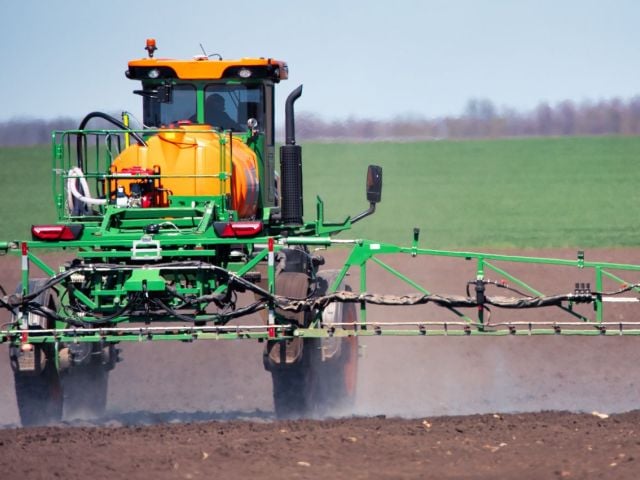
By Alex Formuzis, EWG V-P for Media Relations One of my favorite movie scenes of all time features George C. Scott portraying General George Patton in the film Patton. As he's meeting with other Allied field commanders in a base in North Africa they come under surprise attack from the German Luftwaffe. I hadn't thought about that clip until I read an August 29 article in the Denver Post:
"I came out of a sound sleep and honestly our entire house was shaking, and I said, 'What is that God-awful roar'," said Stephanie Feller, a resident of Sagewater Court in Fossil Lake Ranch (Colorado). "I thought, 'My God, we are all under attack'. " The "God-awful roar" Feller experienced came from a crop duster, not enemy aircraft, and it wasn't gunfire, but pesticides that hit her property."
Again, from the August 29, 2011 edition of the Denver Post: "Feller said immediately after the airplane flew over, her nose and eyes began burning." Folks who live near corn operations in the Midwest are also facing similar incidents of crop duster flyovers. In 2010, Indiana residents filed 24 complaints of aerial pesticide spray drifts with the state's pesticide program. Dave Scott, with the Office of Indiana State Chemist and Seed Commissioner told the Muncie Star Press (Aug. 21, 2011) that "If they get sprayed, they should take their clothing off, stick it in a clean garbage bag, take a shower and call us. The bottom line is, it's OK for crop dusters to be out there, but every product says you can't spray people or drift onto people. If you get sprayed, that's the greatest likelihood of absorbing the stuff." This reminds me of another iconic film clip. Crop Dusters: Back in Vogue For years, the use of crop dusters on the cornfields wasn't always the preferred method to apply pesticides and fungicides to cornrows. It was often too expensive. However, with corn prices at record levels, demand for more of the crop has made aerial application affordable and back IN vogue, including squirting cornfields with the highly toxic pesticide glyphosate, known by Monsanto's trade name RoundUp. According to the August 21 report in The Muncie Star Press, one crop dusting operation was fined $1,250 for applying pesticides without a license. The paper quoted a local resident as complaining that the pesticides "browned his maple leaves and spruce needles, burned his petunias and peonies and spotted his strawberry plants." A lab identified the substance as glyphosate, the paper said. The U.S. Geological Survey recently reported finding widespread glyphosate in air, river and rainwater in Iowa and Mississippi. Unfortunately, people who happen to live in fly zones are being dusted with airborne releases of pesticides and fungicides, causing much concern about the potential impacts these chemical aerial assaults may mean for people's health.
"I am a cancer survivor. I try so hard to avoid this stuff. I don't smoke or drink, so it's very upsetting to be poisoned in my own home. It was coating my house and it also hit me," Selma, Ind., resident Sheri Stewart told the Muncie Star Press.
Dan Cooper of Fort Collins, Colo. described some of the symptoms he experienced shortly after a crop duster buzzed his home. "Dizziness, sinuses swollen, just a little bit stumbly," Cooper told The Coloradoan's Bobby Magill. There are similar stories of pesticide drift into residential areas located near cotton fields from west Texas to Georgia and fruit and near vegetable operations in California. Spray Drift: Is it Floating Your Way? The practice of blasting crops with pesticides is not a precise science - far from it. Spray drift is a common occurrence that can leave homes, playgrounds, schools, backyard swing sets and patio furniture - not to mention people -- covered in toxic chemicals. Of particular concern are schools, playgrounds and daycare facilities located near chemical agriculture operations. The Pesticide Action Network has helped sound the alarm on this issue. According to the network's website:
- Schoolchildren in Strathmore, California, were exposed to pesticides sprayed in a neighboring field in November 2007, after which they reported feeling dizzy and falling sick.
- Eleven people got sick, including seven children who were hospitalized in Kahuku, Hawaii in 2007 when organophosphate insecticide fumes drifted over a school from a nearby sod farm.
Aerial and land pesticide spraying can taint soil, other field crops and nearby waterways. Modern agribusiness is predicted to use more than 1 billion pounds of pesticides annually, with large quantities contaminating local water supplies throughout the country. For nearly a decade, Oluf Johnson's central Minnesota organic farm, which is surrounded by corn and soybean operations, has been the victim of aerial pesticide drift. Johnson and his family have fought the Paynesville Farmers Union Cooperative Oil Co. in court for years. Last July, the Minnesota Court of Appeals ruled that Johnson is entitled to damages from the pesticide cooperative that contaminated his fields, rendering his crop unsalable in the organic market. A California appellate court handed down a similar ruling in December of 2010, awarding an organic herb farmer $ 1 million after a nearby farming operation doused his crop with pesticides. Agriculture chemicals are now so widely used that they can be found in umbilical cord blood of American newborns. Chemical agriculture and its aerial bombardiers have managed to pollute the entire biosphere --including people not yet born. Keep on flying and thanks again (for nothin'), chemical ag.



